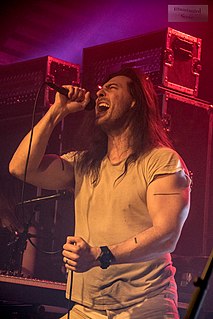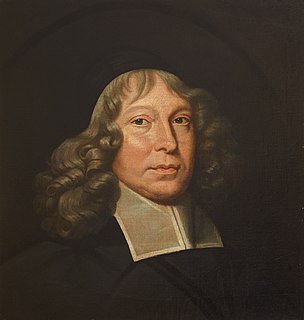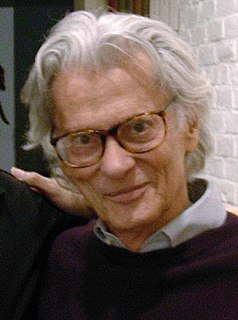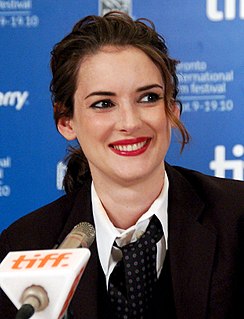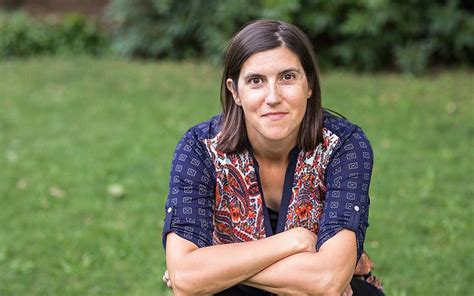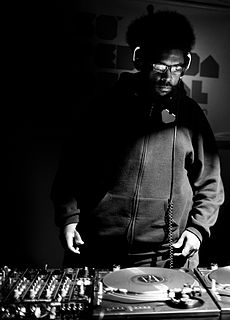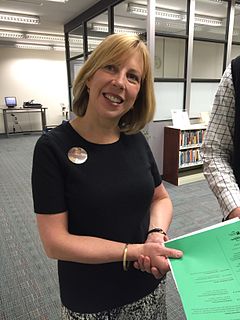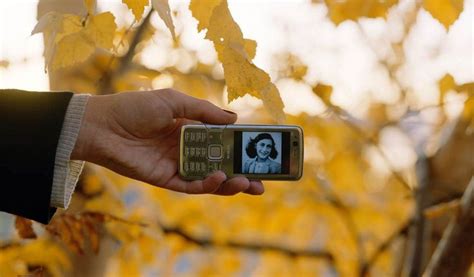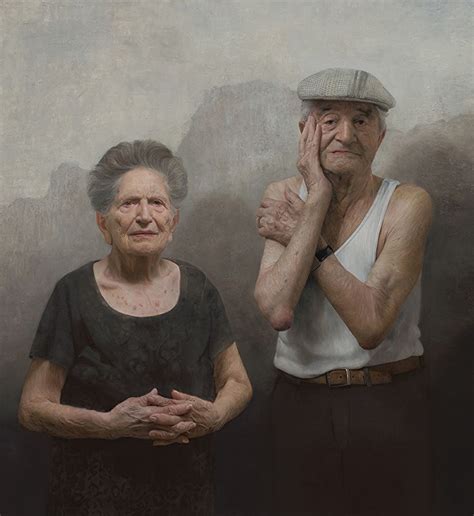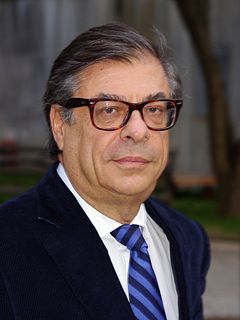Top 260 Portraits Quotes & Sayings - Page 5
Explore popular Portraits quotes.
Last updated on April 19, 2025.
I think that deprecation part is a very important aspect because when someone looks into themselves, if they're going to be honest, they're going to see parts that are humiliating as well as parts that they might feel really great about. Take Lucas Samaras again, who made a lot of self-portraits. He makes one self-portrait where he is looking directly into the camera and looks so intense and cool. He says in an interview, "I wanted to present the best version of myself."
You will not get to steal quietly into heaven, into Christ's company, without a conflict and a cross. I find crosses to be Christ's carved work that he marks out for us and that with crosses he portraits us to his own image, cutting away pieces of our ill and corruption. Lord cut - Lord carve - Lord wound - Lord do anything that may perfect thy Father's image in us and make us ready for glory.
I was always interested in drawing and painting. I enrolled in college to study painting. But I didn't have any livelihood when I graduated. My mother died very young, and I didn't have any home, so I had to find a way to earn a living. It seemed to me that photography - to the great disappointment, I have to say, of my painting teacher - could offer that. So I went and did a degree in photography, and then after that I could go out and get paid for work. For portraits, things like that.
There's always been a separation between fashion and what I call my 'deeper' work. Fashion is where I make my living. I'm not knocking it. It's a pleasure to make a living that way. It's pleasure and then there's the deeper pleasure of doing my portraits. It's not important what I consider myself to be, but I consider myself to be a portrait photographer.
In assembling this group of portraits of women, I'm aware that I'm treading on dangerous ground. When I was in college, I learned to be distrustful of men's depictions of women. I remember seeing Garry Winogrand's book Women Are Beautiful in the school library and being shocked that it hadn't been defaced for its blatant objectification of women. But looking back, maybe I was too harsh. Whether one photographs men or women, it is always a form of objectification. Whatever you say about Winogrand, his depiction was honest.
The most adorable thing about Toronto is that she remains fiercely aloof and indifferent to the fads and entrepreneurial fevers of her lovers. She is intractably herself, admissive to the most vagrant, sober in a way that gets misinterpreted as stodginess. Her generosity extends to the meek as well as the gold diggers. Mercifully, she doesn't give a hoot about our portraits of her, but just waits, patiently, for our affection and citizenship.
I was so lucky that I got to meet certain people. It came through Roddy McDowall, who had become a photographer and would do these portraits of celebrities. Then he would get another well-known person to write a thing. He photographed me when I was 15 or 16, and he got Jason Robards to write the thing because he was sort of my mentor. And Roddy would invite me to these dinner parties that were insane. Like, Elizabeth Taylor and Maureen O'Hara and people that were just crazy. I still can't really believe that I met them.
Bacon's portraits are an interrogation on the limits of the self. Up to what degree of distortion does an individual still remain himself? To what degree of distortion does a beloved person still remain a beloved person? For how long does a cherished face growing remote through illness, through madness, through hatred, through death still remain recognizable? Where is the border beyond which a self ceases to be a self?
Accommodation is a central aspect of the cross-centered interpretation of violent portraits of God that I'm advocating. Like everything else in Cross Vision, this concept is anchored in the cross. On the cross, God stoops to meet us, and to enter into solidarity with us, right where we are at, which is in bondage to sin and to Satan. And he does this to free us and to bring us where he wants us to be, which is united with him in Christ. The cross is thus the paradigmatic example of God mercifully stooping to accommodate people in their fallen conditioning.
I think a bigger difference with social media is going to be things like the impact Instagram will have for historians. For the longest time, we had no images of the past. And then when we had the advent of the camera, we had a record of the things people chose to photograph, which, for a while, were portraits of your family, a new building we built, or a really big horse. Well now we have images of everything. That will be the biggest difference I think - that we will have a visual record of this reality in a way that will be completely covered.
I think self-portraits are very difficult. I’ve always seen mine as straightforward, very stripped down, hair pulled back. No shirt. Whatever light happened to be available. I’d want it to be very graphic – about darkness and light. No one else should be there, but I’m scared to do it by myself. I’ve been thinking about it for a long time. The whole idea of a self-portrait is strange. I’m so strongly linked to how I see through the camera that to get to the other side of it would be difficult. It would be as if I were taking a photograph in the dark.
We all stood and gathered our backpacks and I looked at the floor around my chair to make sure I hadn’t dropped anything. I was terrified of unwittingly leaving behind a scrap of paper on which were written all my private desires and humiliations. The fact that no such scrap of paper existed, that I did not even keep a diary or write letters except bland, earnest, falsely cheerful ones to my family (We lost to St. Francis in soccer, but I think we’ll win our game this Saturday; we are working on self-portraits in art class, and the hardest part for me is the nose) never decreased my fear.
Resistance here doesn't mean revolution. It doesn't mean storming the barricades. Resistance means using art for the things that it does best, which is to create human portraits and communicate ideas and forge a climate where people of different races or classes are known to you because they make themselves known. In the simplest terms, art humanizes. It opens the circuit of empathy. And once that process happens, it's that much harder to think of people as part of a policy or a statistic. Art reverses the alienation that can creep into society.
In my teens I fancied myself an artist; I hung out with the eccentric art teacher at my high school, painted still lifes and portraits and landscapes in watercolor and acrylics, took private lessons, won some blue ribbons for my earnest renderings. My lack of talent did little to dampen my enthusiasm. In college I thought I'd continue, but, like Salieri, I quickly realized that while I had the ability to appreciate art, I wasn't actually very good.
Many who are convinced that God is non-violent simply dismiss the Old Testament accounts of God commanding or engaging in violence. I don't consider this to be a viable option, for Jesus treats the whole Old Testament as the inspired Word of God. My cross-centered interpretation of these violent portraits allows believers to affirm that God is non-violent while also affirming that all Scripture is "God-breathed.".
I've found that photographs from different genres can be extraordinarily generous with each other. I started out photographing myself in a landscape, moved on to landscapes with and without other people, and then onto buildings, still lives, portraits, and body parts in rooms. If certain aspects of my production are getting more attention right now I think it is directly linked to a general absence of dreamed bodies in contemporary art. Viewers who mainly follow fashion have most likely not noticed this lack.
Here and there, in some older houses, old faded daguerreotypes still hang on the walls... They seem to us to be very simple... compared with the artistic and skillful portraits made in later days... Here was a photograph that at one time had been the last word, a very modern portrait... Today it is just a part of cultural history. The small yellowed surface has acquired depth, an admonishing perspective. We hold in our hand a symbol of the structure and ideology of an epoch.
I sort of feel that the role of a portrait in society is to represent the sitters, we see paintings of Shakespeare and we believe that it is what he looked like, well maybe a little older, fatter and with a higher hairline. I guess it would be cool if the portraits that were painted really did look like the sitter or expressed some sort of emotion that gave the viewers in the future a sense of the sitter's pathos at the time it was painted.
I think his portraits of Jackie, Liz, Marilyn, Mao, Elvis, Lenin - and objects like the soup cans, the dollar signs, the hammer and sickle, it's all about icons. Its all about what people worship in an irreligious or secular world. In terms of Andy's personality and Andy Warhol as a human being who I was very close to, I still feel kind of sorry for him on a personal level. I mean, he was the ultimate example of great success wrapped around inner turmoil and emotional pain.
My early self-portraits appeared effortlessly and seemed like equivalents for my deeper emotions. Many critics remarked that the images had an almost other-worldly haunting presence. For me, they were simply my own reality at that point in my life. What I was trying to reveal was my inner soul in all its fragile complexity. Without knowing it, I was trying to peel back the layers that shroud and bind us all as we struggle to reveal our own authentic selves.
